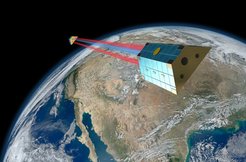New laser instrument onboard GRACE-Follow-On measures Earth's gravity field with high precision
One year in operation: the first laser interferometer between two satellites exceeds all expectations and is a successful step towards the space-based gravitational-wave observatory LISA
Since the end of May 2018, the two GRACE Follow-On satellites have been orbiting the Earth and measuring its gravitational field by monitoring the distance between them. This enables them to observe regional groundwater levels and global indicators of climate change. In addition to established technology, a new type of laser instrument (Laser Ranging Interferometer) has been in use for the first time since mid-June 2018. It measures 200 times more precisely and records changes in the distance of 220 kilometers with atom-diameter precision. An international research team, including researchers from the Max Planck Institute for Gravitational Physics (Albert Einstein Institute / AEI) and Leibniz University in Hanover, has now published initial results on the commissioning and performance of the laser instrument in Earth orbit. These exceed all expectations and show that the instrument works perfectly.
After the first major success – the successful “first light” of the Laser Ranging Interferometer (LRI) in June 2018 – the instrument worked perfectly apart from interruptions due to mission operations. Continuous measurements of more than 1000 orbits around the Earth show the instrument's reliability. Fast reacting control mirrors ensure that the laser connection between the satellites is not interrupted while the satellites are slightly jittering in their orbits. The international team used the data obtained to understand and evaluate the performance of the LRI in Earth orbit. The results are impressive:
More precise technology for future satellite missions

“The Laser Ranging Interferometer on board GRACE Follow-On works perfectly – it's a dream! The instrument measures distance changes between the satellites very precisely, about 200 times more precisely than the established microwave technology and thus 20 times more precisely than specified in the mission requirement,” says Prof. Gerhard Heinzel, head of the Space Interferometry group at AEI and manager of the German contributions to the LRI. “This will not only make future Earth observation satellite missions even more accurate, but will also pave the way for gravitational-wave observation in space with LISA”. The international team of researchers has now published the results in the journal Physical Review Letters.
“The laser beam from one satellite has to point at the other exactly in order for our distance measurement to be so precise,” Heinzel explains. “Initially, the laser is aligned so well that it would hit a plate at a distance of 100 meters. For a successful laser connection, we then have to point it at a two-Euro coin on this plate. When the automatic targeting mechanism has done this by means of the control mirrors, it always targets a point in the inner half of the coin with the highest accuracy. We then always hit Mallorca on the two-Euro coin at a distance of 100 meters, while the satellites’ jitter moves the coin around three centimeters!

GRACE Follow-On continues the successful observations of the GRACE mission (2002-2017) since mid-2018 using the established microwave distance measurement of the previous mission. The LRI is a demonstrator that tests technology for future missions, but at the same time delivers measurement data of the highest accuracy. The LRI determines the changes in distance between the satellites to within fractions of a nanometer, which is roughly equivalent to an atomic diameter.
Solving the mystery of laser data jumps
“A surprise in the LRI measurement data were sudden jumps in the laser measurements – a mystery that we have solved with our analysis over the past few months,” explains Dr. Vitali Müller, a researcher in the Space Interferometry group at AEI. “If the satellites activate their thrusters for attitude control several times per Earth orbit, the jumps are easily detected and corrected in the measured data. These jumps do not affect the performance of the LRI.”
Weighing the ice on Earth from space
“Only satellite observations from space can track on the entire Earth how ice masses, groundwater levels, and other indicators of the Earth system that are important for the future of mankind change over the months and years,” says Prof. Karsten Danzmann, Director at AEI Hannover and Director of the Institute of Gravitational Physics at Leibniz Universität Hannover.
Although the LRI had to function as a demonstration experiment for only half a year, there are no signs of aging. The high-precision LRI measurements will therefore continue for a long time to come. The LRI measurement data of the first year will be published at the end of July 2019, thereafter on a regular basis. The data from the other instruments are already available online.













